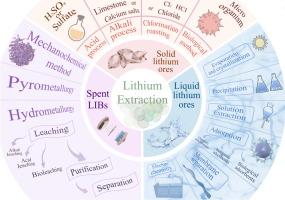当前位置:
X-MOL 学术
›
Sep. Purif. Technol.
›
论文详情
Our official English website, www.x-mol.net, welcomes your
feedback! (Note: you will need to create a separate account there.)
Research progress of technology of lithium extraction
Separation and Purification Technology ( IF 8.1 ) Pub Date : 2024-11-16 , DOI: 10.1016/j.seppur.2024.130561 Yanjia Zhou, Xiaodong Tang, Dayong Qing, Jingjing Li, Hong Wang
Separation and Purification Technology ( IF 8.1 ) Pub Date : 2024-11-16 , DOI: 10.1016/j.seppur.2024.130561 Yanjia Zhou, Xiaodong Tang, Dayong Qing, Jingjing Li, Hong Wang

|
Lithium (Li) is a core strategic metal in the new energy industry. Due to its wide range of applications in various fields, the demand from the resource market is growing year by year. At present, Li is mostly extracted from lithium minerals (solid lithium ore and liquid lithium ore), seawater and spent lithium-ion batteries (LIBs). This paper focuses on the lithium extraction process of various lithium resources, expounds its reaction mechanism and application performance, and puts forward the possible future development direction. The extraction of lithium from solid lithium ores by the acid process has good practical applications but poor environmental sustainability. Additionally, the proportion of lithium resources of liquid lithium ore (brine) is greater than that of solid lithium ore, and extracting lithium from brine is the most valuable choice at present. The Li content in the brine is typically low. Lithium extraction with inorganic adsorbent is the most advanced method at present. Different techniques include evaporative crystallization, precipitation, solvent extraction, adsorption with organic and biological adsorbent, membrane separation, and electrochemical methods. However, most of the technologies with favorable economic benefits and high efficiency are still difficult to achieve large-scale industrialization. Therefore, it is still a great challenge to develop an economical, environmentally friendly, efficient and practical technology for extracting lithium from brine. Furthermore, with the rise and vigorous development of the LIBs market, the treatment and recycling of spent LIBs has become a major problem. According to the research, it is feasible to extract lithium from spent LIBs and achieve industrialization and recycling. Therefore, research on lithium extraction from spent LIBs is also the key to increasing the supply of lithium resources and achieving resource recycling.
中文翻译:

锂提取技术研究进展
锂 (Li) 是新能源行业的核心战略金属。由于其在各个领域的广泛应用,资源市场的需求逐年增长。目前,锂主要从锂矿物(固体锂矿石和液态锂矿石)、海水和废锂离子电池 (LIB) 中提取。本文重点介绍了各种锂资源的提锂工艺,阐述了其反应机理和应用性能,并提出了未来可能的发展方向。通过酸法从固体锂矿石中提取锂具有良好的实际应用,但环境可持续性较差。此外,液态锂矿(卤水)的锂资源比例大于固体锂矿石,从卤水中提取锂是目前最有价值的选择。盐水中的锂含量通常很低。无机吸附剂提锂是目前最先进的方法。不同的技术包括蒸发结晶、沉淀、溶剂萃取、有机和生物吸附剂吸附、膜分离和电化学方法。然而,大多数经济效益好、效率高的技术仍难以实现大规模产业化。因此,开发一种经济、环保、高效、实用的盐水提锂技术仍然是一个巨大的挑战。此外,随着锂离子电池市场的兴起和蓬勃发展,废锂离子电池的处理和回收已成为一个重大问题。根据该研究,从废锂离子电池中提取锂并实现工业化和回收是可行的。 因此,从废锂离子电池中提取锂的研究也是增加锂资源供应和实现资源循环利用的关键。
更新日期:2024-11-16
中文翻译:

锂提取技术研究进展
锂 (Li) 是新能源行业的核心战略金属。由于其在各个领域的广泛应用,资源市场的需求逐年增长。目前,锂主要从锂矿物(固体锂矿石和液态锂矿石)、海水和废锂离子电池 (LIB) 中提取。本文重点介绍了各种锂资源的提锂工艺,阐述了其反应机理和应用性能,并提出了未来可能的发展方向。通过酸法从固体锂矿石中提取锂具有良好的实际应用,但环境可持续性较差。此外,液态锂矿(卤水)的锂资源比例大于固体锂矿石,从卤水中提取锂是目前最有价值的选择。盐水中的锂含量通常很低。无机吸附剂提锂是目前最先进的方法。不同的技术包括蒸发结晶、沉淀、溶剂萃取、有机和生物吸附剂吸附、膜分离和电化学方法。然而,大多数经济效益好、效率高的技术仍难以实现大规模产业化。因此,开发一种经济、环保、高效、实用的盐水提锂技术仍然是一个巨大的挑战。此外,随着锂离子电池市场的兴起和蓬勃发展,废锂离子电池的处理和回收已成为一个重大问题。根据该研究,从废锂离子电池中提取锂并实现工业化和回收是可行的。 因此,从废锂离子电池中提取锂的研究也是增加锂资源供应和实现资源循环利用的关键。


















































 京公网安备 11010802027423号
京公网安备 11010802027423号